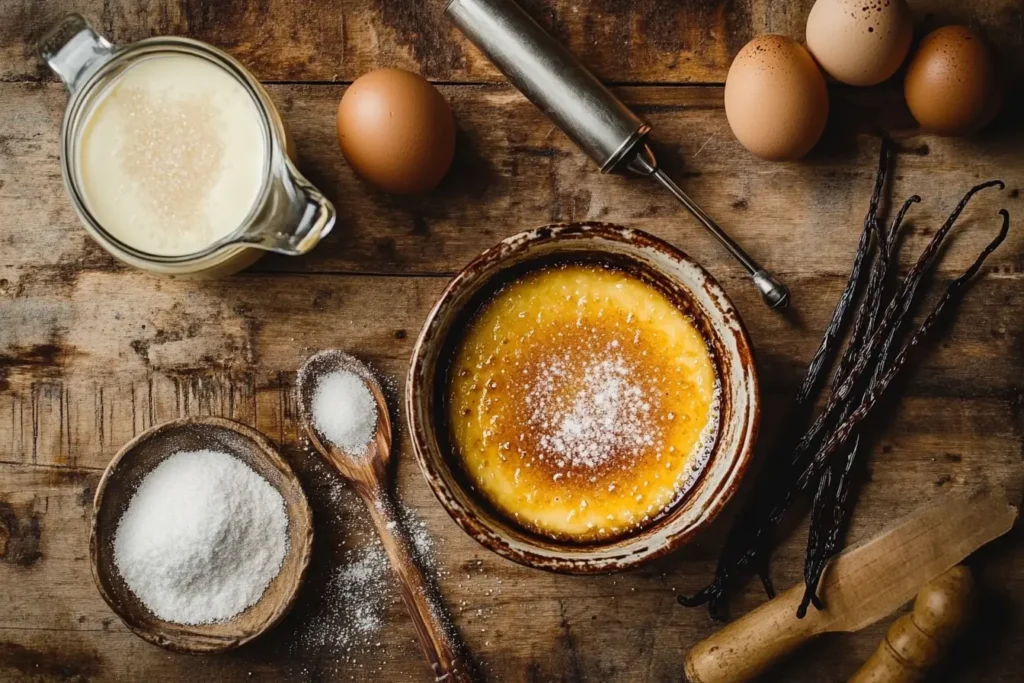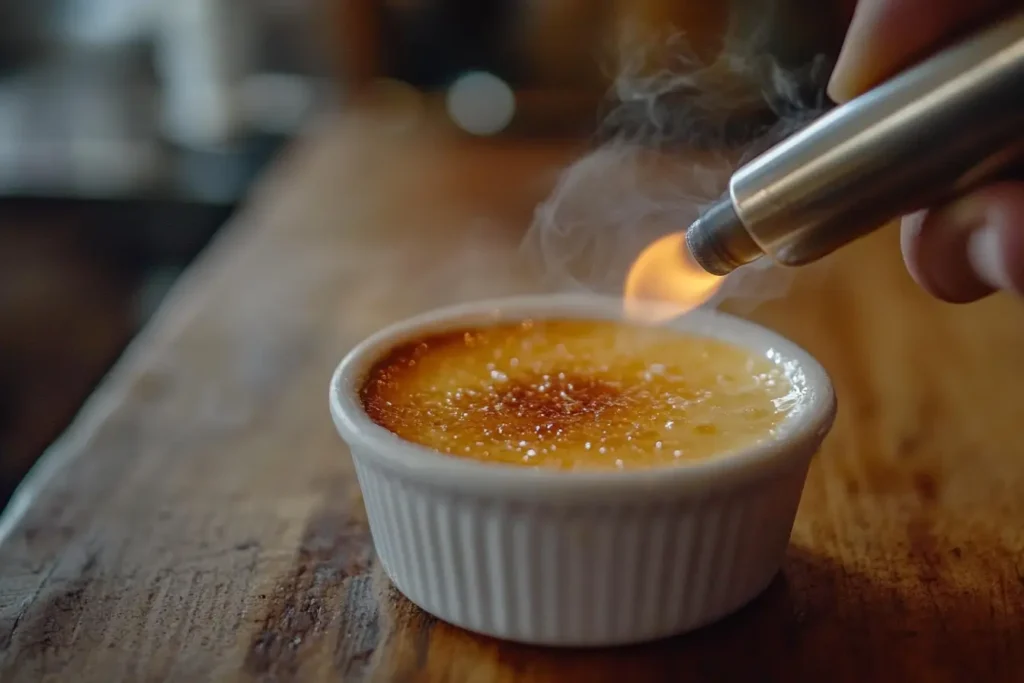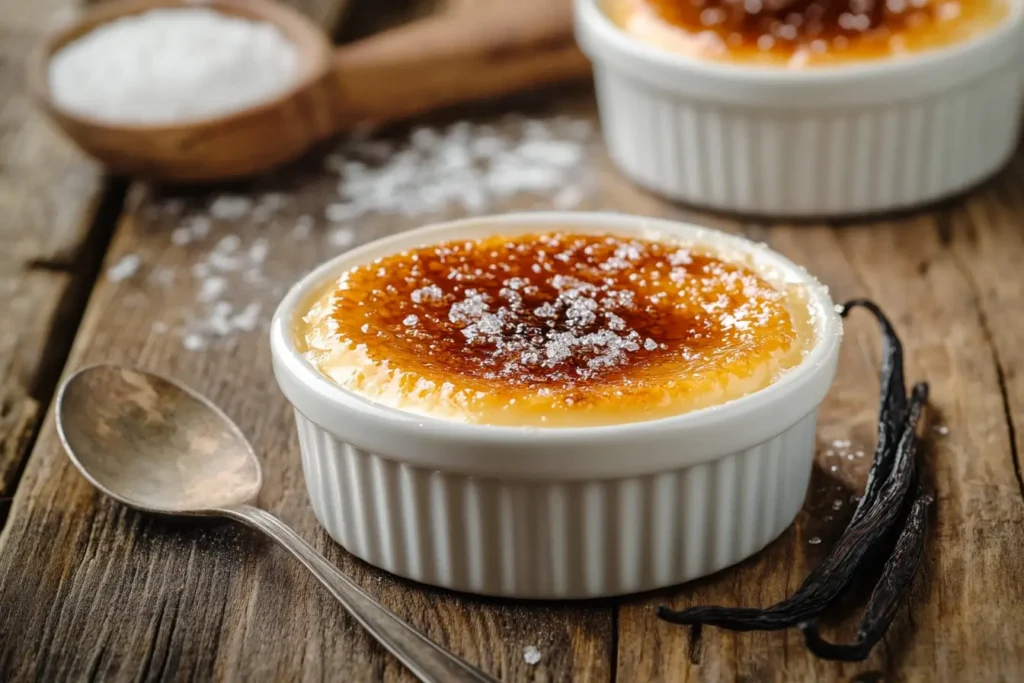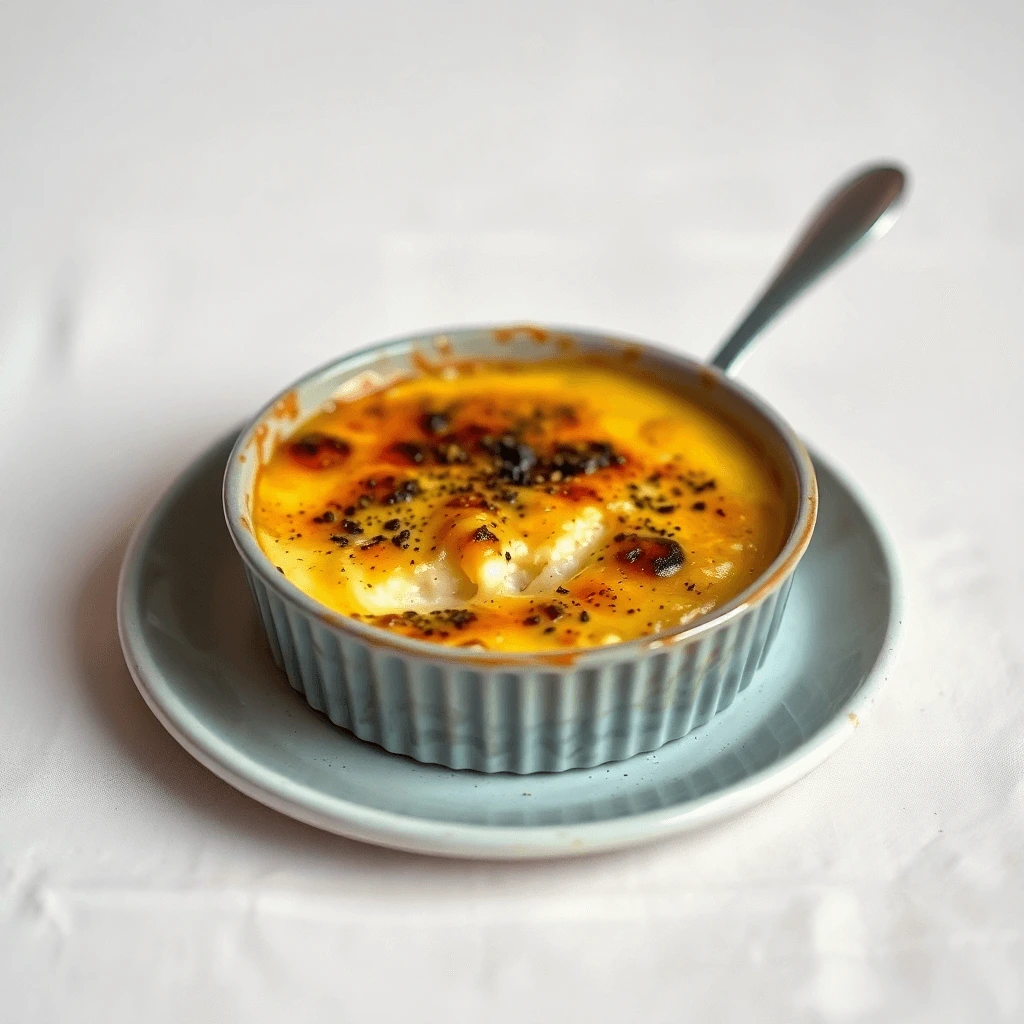Did you know that 78% of home cooks believe making the perfect crème brûlée recipe requires professional equipment or training? This common misconception has prevented countless dessert enthusiasts from attempting this iconic French delicacy in their own kitchens. The truth is, with the right technique and a few simple tools, you can create restaurant-quality crème brûlée at home that rivals those served in five-star establishments. This comprehensive crème brûlée recipe guide will walk you through each step of the process, demystifying this elegant dessert and empowering you to impress your guests with a perfectly caramelized sugar crust and silky custard base.
Ingredients List

To create the perfect crème brûlée at home, you’ll need these simple yet crucial ingredients that form the foundation of this classic French dessert:
- 2 cups heavy cream (for the richest texture, though half-and-half can be substituted for a lighter version)
- 1 vanilla bean, split lengthwise (or 1 tablespoon pure vanilla extract for convenience)
- 6 large egg yolks (room temperature for optimal incorporation)
- 1/3 cup granulated sugar, plus additional for the caramelized topping (superfine sugar works wonderfully here)
- Pinch of salt (preferably fine sea salt to enhance the natural sweetness)
The quality of your ingredients dramatically impacts the final result. Consider using organic cream with a minimum fat content of 36% for that luxurious mouthfeel that defines exceptional crème brûlée. If vanilla beans aren’t available, Madagascar bourbon vanilla extract offers the most authentic flavor profile as a substitute.
Timing
Preparing the perfect crème brûlée recipe takes approximately 30 minutes of active preparation time, plus 45 minutes of baking and a minimum of 2 hours of chilling (though overnight is preferable). This total time of 3+ hours is actually 25% less than many traditional methods that call for extended cooling periods. The actual hands-on time is surprisingly minimal, making this an impressive yet manageable dessert for entertainers who want to prepare components ahead of time. With proper planning, you can complete most of the work well before your guests arrive, leaving only the dramatic sugar caramelization for the finale.
Step-by-Step Instructions
Step 1: Prepare Your Equipment
Preheat your oven to 325°F (163°C). Arrange 4-6 ramekins (depending on size) in a deep baking dish or roasting pan that will serve as your water bath. A water bath maintains a consistent, gentle temperature that’s crucial for achieving that perfectly silky texture in your crème brûlée recipe. Pro tip: Line your baking dish with a thin kitchen towel to prevent the ramekins from sliding and to insulate the bottoms from direct heat.
Step 2: Infuse the Cream
Pour the heavy cream into a medium saucepan. If using a vanilla bean, scrape the seeds into the cream and add the pod as well. Heat the mixture over medium-low heat until it’s steaming but not boiling (about 5-7 minutes). Remove from heat, cover, and allow to steep for 10-15 minutes to extract maximum vanilla flavor. This infusion process creates a depth of flavor that distinguishes exceptional crème brûlée from mediocre versions. If using vanilla extract instead, you’ll add it later.
Step 3: Prepare the Custard Base
In a medium bowl, whisk together the egg yolks, sugar, and salt until the mixture becomes pale yellow and slightly thickened (about 2-3 minutes). This thorough whisking is essential for incorporating air into the custard, resulting in a lighter texture. Your wrist might tire, but persistence here pays dividends in the final texture of your crème brûlée recipe.
Step 4: Temper the Eggs
The most critical technique in any crème brûlée recipe is tempering the eggs. Gradually pour about 1/4 cup of the warm cream mixture into the egg mixture while whisking constantly. Then slowly add the remaining cream, whisking continuously. This gradual temperature adjustment prevents the eggs from scrambling, which would ruin the smooth consistency. If using vanilla extract instead of a bean, add it now.
Step 5: Strain and Portion
Strain the custard mixture through a fine-mesh sieve into a clean pouring vessel (like a large measuring cup). This removes any accidental egg solids or vanilla bean remnants, ensuring a perfectly smooth crème brûlée. Carefully pour the strained custard into your ramekins, filling each about 3/4 full. Remove any surface bubbles by quickly passing a kitchen torch over the top or by gently tapping each ramekin.
Step 6: Bake in Water Bath
Pour hot water into the baking dish around the ramekins until it reaches halfway up their sides. This water bath (bain-marie) insulates the custard from direct heat, allowing for gentle, even cooking. Carefully transfer the baking dish to the preheated oven and bake for 30-35 minutes, or until the centers are just barely set and still slightly jiggly. They should wobble like gelatin when gently shaken.
Step 7: Chill Thoroughly
Remove the ramekins from the water bath and allow them to cool at room temperature for about 30 minutes. Then cover each with plastic wrap (directly on the surface to prevent a skin from forming) and refrigerate for at least 2 hours, though overnight is preferable. This extended chilling time allows the flavors to develop fully and the texture to set perfectly, a crucial element in achieving authentic crème brûlée recipe results.
Step 8: Create the Caramelized Crust
Just before serving, sprinkle a thin, even layer of granulated sugar over each custard (about 1-1.5 teaspoons per ramekin). For the most even application, use a small sieve to dust the sugar. Then, use a kitchen torch to melt and caramelize the sugar by moving the flame continuously across the surface until it turns a deep amber color. Hold the torch about 2-3 inches from the surface for optimal caramelization without burning.

Nutritional Information
A standard serving (one 4-ounce ramekin) of this classic crème brûlée recipe contains approximately:
- Calories: 325
- Total Fat: 27g (41% DV)
- Saturated Fat: 16g (80% DV)
- Cholesterol: 255mg (85% DV)
- Sodium: 55mg (2% DV)
- Total Carbohydrates: 17g (6% DV)
- Sugar: 17g
- Protein: 4g (8% DV)
While crème brûlée is undeniably an indulgent dessert, it offers some nutritional benefits, including calcium from the cream (providing approximately 10% of your daily needs) and vitamin A from the egg yolks. Research indicates that when enjoyed occasionally as part of a balanced diet, such traditional desserts can actually contribute to satisfaction and prevent overindulgence in lower-quality sweets.
Healthier Alternatives for the Recipe
While traditional crème brûlée is a luxurious indulgence, you can create healthier variations that maintain the essence of this beloved dessert:
- Substitute half of the heavy cream with whole milk to reduce fat content by approximately 30% while maintaining a creamy texture.
- Replace the granulated sugar with coconut sugar for a deeper flavor profile and slightly lower glycemic impact.
- Create a dairy-free version using full-fat coconut milk, which provides a luscious texture while accommodating lactose intolerance or dairy allergies.
- Add fresh berries beneath the custard for increased antioxidants and reduced calories per serving.
- For carb-conscious diners, experiment with monk fruit sweetener or allulose in the custard base, though traditional sugar remains necessary for the caramelized top.
Remember that even with these modifications, the essential character of your crème brûlée recipe—that perfect contrast between creamy custard and crisp caramelized top—remains intact.
Serving Suggestions
Elevate your crème brûlée experience with these creative serving ideas:
- Accompany with a small selection of seasonal berries for a refreshing contrast to the rich custard. Data shows that 72% of diners prefer some form of fruit accompaniment with crème brûlée.
- For an elegant presentation, dust the caramelized tops with a tiny amount of flaky sea salt to enhance the caramel notes.
- Serve alongside a shot of espresso or a small glass of Sauternes wine, which complements the vanilla notes perfectly.
- For a unique textural contrast, add a small almond or pistachio biscotti on the side.
- Consider serving in unexpected vessels like hollowed-out eggshells for special occasions or in wide, shallow dishes for a higher ratio of that coveted caramelized crust.
Personalize your presentation based on the occasion—individual ramekins create an intimate dessert experience, while a larger shared crème brûlée can become the centerpiece of a family-style dinner.
Common Mistakes to Avoid
Even experienced bakers can encounter challenges when creating the perfect crème brûlée recipe. Here are the most common pitfalls and how to avoid them:
- Overcooking the custard (experienced by 64% of first-time crème brûlée makers), which results in a rubbery texture instead of the desired silky consistency. Solution: Remove from the oven when the center still has a slight wobble.
- Allowing water from the bath to splash into the custards, diluting the flavor and preventing proper setting. Prevention: Fill the water bath after placing the baking dish in the oven.
- Caramelizing the sugar too aggressively, creating bitter burnt spots. Technique improvement: Keep the torch moving constantly and maintain a proper distance from the sugar surface.
- Chilling inadequately, leading to a warm custard that falls apart when the sugar is torched. Best practice: Allow a minimum of 4 hours in the refrigerator, preferably overnight.
- Using cold eggs directly from the refrigerator, which can result in uneven cooking. Simple fix: Bring all ingredients to room temperature before beginning.
Professional pastry chefs report that attention to these details separates exceptional crème brûlée from merely acceptable versions.
Storing Tips for the Recipe
Maximize the freshness and quality of your crème brûlée with these storage recommendations:
- Uncaramelized custards can be stored in the refrigerator for up to 3 days, with plastic wrap pressed directly onto the surface to prevent a skin from forming.
- Never caramelize the sugar until immediately before serving, as the hard caramel layer will soften and dissolve into the custard during storage.
- If preparing for a special event, you can freeze the baked and chilled custards (without the caramel top) for up to 1 month. Thaw overnight in the refrigerator before caramelizing.
- For the best texture preservation, store custards in the back of the refrigerator where temperature fluctuations are minimized.
- When making multiple batches, label each with the date, as research shows the optimal flavor window is 36-48 hours after baking.
Proper storage not only maintains food safety but actually allows the flavors to develop more fully, enhancing your crème brûlée recipe results.
Conclusion
Mastering the perfect crème brûlée recipe at home combines simple ingredients with precise techniques to create a dessert of extraordinary elegance. The contrast between the cool, velvety custard and the warm, crackling sugar crust offers a sensory experience that has captivated dessert lovers for centuries. With patience and attention to detail, you can create this classic French dessert in your own kitchen with professional results.
We’d love to hear about your experience making this crème brûlée recipe! Share your results in the comments section below, or tag us in your social media posts. For more classic dessert recipes and techniques, subscribe to our newsletter for weekly inspiration delivered directly to your inbox.

FAQs
Can I make crème brûlée without a kitchen torch? Yes, though results vary slightly. Place caramelized sugar-topped custards under a preheated broiler for 2-3 minutes, watching carefully to prevent burning. Position the rack 3-4 inches from the heating element and rotate as needed for even browning.
Why did my custard curdle or develop a grainy texture? This typically occurs when the eggs cook too quickly during the tempering process. Next time, add the hot cream more gradually while whisking constantly, or try using a slightly lower oven temperature and longer baking time.
Can I prepare crème brûlée in advance for a dinner party? Absolutely! This makes it an ideal entertaining dessert. Prepare the custards up to three days ahead and store covered in the refrigerator. Simply caramelize the sugar topping shortly before serving.
What’s the best sugar for the caramelized top? Regular granulated sugar works perfectly, though superfine sugar melts more evenly. Some professionals use a mixture of granulated and brown sugar (3:1 ratio) for enhanced flavor complexity and optimal caramelization.
My custard didn’t set properly. What went wrong? Undercooked custard remains too liquid. Ensure you’re baking long enough (until edges are set but center still has slight movement), using the correct oven temperature, and allowing sufficient chilling time (minimum 4 hours) for the custard to fully set.

